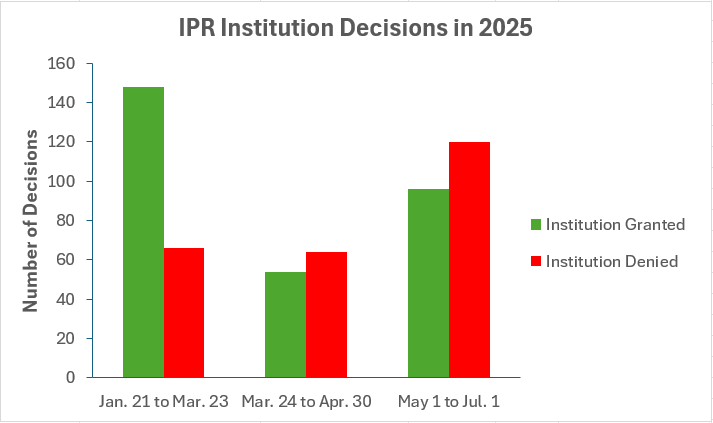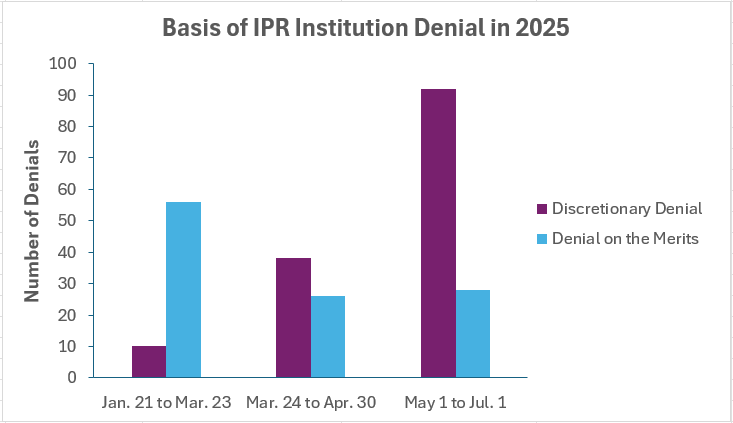[co-author: Daniel Moriarty (Summer Associate)]
Inter partes review (IPR) proceedings are a cost-effective way by which patent challengers can dispute the validity of an issued patent. To institute an IPR, the Patent Trial and Appeal Board (PTAB) must determine that the patent challenger has a reasonable likelihood of success in showing that at least one challenged claim is unpatentable (a decision “on the merits”).[1] Even where this standard is met, the PTAB may exercise its discretion to deny petitions to institute an IPR where there are external, procedural considerations, such as parallel proceedings in a district court.[2] Under the Biden Administration, guidance issued by then U.S. Patent and Trademark Office (USPTO) Director Vidal limited the PTAB’s ability to deny institution of IPR proceedings on discretionary grounds,[3] which were historically guided by the six Fintiv factors that weighed the efficiency of instituting an IPR in light of ongoing district court litigation.[4] This guidance was repealed by Acting Director Coke Morgan Stewart on February 28, 2025[5] and, in March 2025, more recent guidance from Chief Administrative Patent Judge Boalick granted the PTAB wider latitude to deny institution on discretionary grounds, even where the substance of the patent challenge is strong on the merits.[6] In the weeks after the issuance of this new guidance, observers speculated that the IPR institution rate could return to pre-guidance figures as patent challengers adapted their strategies to address the increased threat from discretionary denials.[7] This article assesses the degree to which this has happened in the four months since Judge Boalick issued the revised guidance.
Between January 21, 2025 — the day the new administration took office — and March 23, 2025 — the day before the issuance of the new guidance — the PTAB issued 214 institution decisions, granting institution in 148 cases and denying institution in 66 cases. Of these 66 cases in which the PTAB denied institution, only 10 cases were on discretionary grounds. During this period, the PTAB instituted IPR proceedings for 69% of petitions filed, and only 15% of denials were based on discretionary grounds.[8]
In the immediate aftermath of Judge Boalick’s new guidance — March 24 to April 30, 2025 — the PTAB made decisions on 118 IPR petitions, granting institution in 54 cases and denying institution in 64 cases. Of these 64 cases in which the PTAB denied institution, 38 of the denials were on discretionary grounds. When compared with the previously observed period, the overall institution rate dropped sharply from 69% to 46%. Notably, denials based on discretionary grounds rose during this period from 15% to 59%.[9]
A patent owner has three months from the filing of the petition to file a response. Therefore, in the period observed from March 24 to April 30, 2025, many of the institution decisions would have occurred before patent owners had a chance to change their strategy and focus on procedural arguments. For this reason, it is likely that more recent data serves as a more accurate indicator of the long-term impact of the new guidance.
Despite predictions that the overall institution rate would stabilize and return to pre-guidance figures as patent challengers became familiar with the threat of the Fintiv factors and proceeded with challenges accordingly,[10] the evidence does not bear this out. From May 1 to July 1, 2025, the PTAB issued 216 institution decisions, granting institution in 96 cases and denying institution in 120 cases. Of the 120 denials, 92 were on discretionary grounds. Compared with the previous period, the overall institution rate declined from 46% to 44%, while the percentage of discretionary denials increased from 59% to 77%. Overall, these figures represent a paradigmatic shift in the way that the PTAB makes IPR institution decisions, with the rate of discretionary denials rising from 15% to 77% from pre-guidance figures.
The changes observed in the period from May 1 to July 1, 2025, reflect more than a short-term spike in discretionary denials by the PTAB. Based on this data, IPR institution rates will likely not return to previous levels, at least while the current guidance remains in place. The reimplementation of the Fintiv factors creates both a renewed hurdle for patent challengers and an expanded avenue for patent owners to secure denials, even where the merits of the challenge may be strong. With over three-quarters of institution denials currently based on discretionary grounds, patent challengers should be extremely wary of parallel proceedings and other external factors that could lead to a PTAB denial on discretionary grounds.


It is possible that patent owners are now leaning into the new guidance, paying increased attention to procedural arguments that would not have been seriously considered under the previous guidance. One such strategy is an increased interest in starting litigation in “friendly jurisdictions” — such as the Eastern or Western District of Texas — where cases tend to move quickly because the stage of the litigation proceeding impacts two Fintiv factors (Factor 2: “Trial Date Proximity” and Factor 3: “Investment in Parallel Proceeding”)[11] knowing that parallel PTAB proceedings face a higher risk of discretionary denial.
As patent owners adjust their strategies in response to this guidance, patent challengers must adapt as well. The data presented here suggests that patent challengers should quickly file an IPR petition if they are concerned about possible litigation, thereby minimizing the risk of a discretionary denial.
[1] 35 U.S.C. § 314(a) (2022).
[2] Apple Inc. v. Fintiv, Inc., IPR2020-00019, Paper 11 (P.T.A.B. Mar. 20, 2020).
[3] U.S. Patent & Trademark Office, Memorandum on Interim Procedure for Discretionary Denials in AIA Post-Grant Proceedings with Parallel District Court Litigation (June 21, 2022), https://www.uspto.gov/sites/default/ files/ doc uments/20220621_Interim_proc_discrty_denials_AIA_parallel_DC_lit.pdf.
[4] Id.
[5] U.S. Patent & Trademark Office, Guidance on USPTO’s Recission of “Interim Procedure for Discretionary Denials in AIA Post-Grant Proceedings with Parallel District Court Litigation” (Mar. 24, 2025).
[6] Id.
[7] Mike Rueckheim et al., The PTAB’s Institution Grant Rate Has Dropped After Announcement of the New PTAB Discretionary Denial Guidance and Briefing Procedure, Winston & Strawn LLP (May 5, 2025), https://www.winston.com/en/insights-news/the-ptabs-institution-grant-rate-has-dropped-after-announcement-of-the-new-ptab-discretionary-denial-guidance-and-briefing-procedure.
[8] Id.
[9] Id.
[10] Id.
[11] Apple Inc. v. Fintiv, Inc., IPR2020-00019, Paper 11 (P.T.A.B. Mar. 20, 2020).
[View source.]